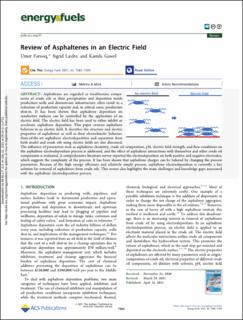| dc.contributor.author | Farooq, Umer | |
| dc.contributor.author | Lædre, Sigrid | |
| dc.contributor.author | Gawel, Kamila | |
| dc.date.accessioned | 2021-12-03T10:32:14Z | |
| dc.date.available | 2021-12-03T10:32:14Z | |
| dc.date.created | 2021-07-14T16:39:10Z | |
| dc.date.issued | 2021 | |
| dc.identifier.citation | Energy & Fuels. 2021, 35 (9), 1-20. | en_US |
| dc.identifier.issn | 0887-0624 | |
| dc.identifier.uri | https://hdl.handle.net/11250/2832730 | |
| dc.description.abstract | Asphaltenes are regarded as troublesome components of crude oils as their precipitation and deposition inside production wells and downstream infrastructure often result in a reduction of production capacity and, in critical cases, production shut-in. It has been shown that asphaltene deposition on conductive surfaces can be controlled by the application of an electric field. The electric field has been used to either inhibit or accelerate asphaltene deposition. This paper reviews asphaltene behavior in an electric field. It describes the structure and electric properties of asphaltenes as well as their electrokinetic behavior. State-of-the-art asphaltene electrodeposition and separation from both model and crude oils using electric fields are also discussed. The influence of parameters such as asphaltene chemistry, crude oil composition, pH, electric field strength, and flow conditions on the asphaltene electrodeposition process is addressed, and the effect of asphaltene interactions with themselves and other crude oil components is evaluated. A comprehensive literature survey reported the electrodeposition on both positive and negative electrodes, which suggests the complexity of the process. It has been shown that asphaltene charges can be tailored by changing the process parameters. Because of the high energy efficiency and relatively simple process, asphaltene electrodeposition is currently a key solution for removal of asphaltenes from crude oils. This review also highlights the main challenges and knowledge gaps associated with the asphaltene electrodeposition process. | en_US |
| dc.language.iso | eng | en_US |
| dc.publisher | ACS Publications | en_US |
| dc.rights | Navngivelse 4.0 Internasjonal | * |
| dc.rights.uri | http://creativecommons.org/licenses/by/4.0/deed.no | * |
| dc.subject | Electrical properties | en_US |
| dc.subject | Polarity | en_US |
| dc.subject | Petrochemicals | en_US |
| dc.subject | Aromatic compounds | en_US |
| dc.subject | Hydrocarbons | en_US |
| dc.title | Review of asphaltenes in an electric field | en_US |
| dc.type | Peer reviewed | en_US |
| dc.type | Journal article | en_US |
| dc.description.version | publishedVersion | en_US |
| dc.rights.holder | © 2021 The Authors. Published by American Chemical Society | en_US |
| dc.source.pagenumber | 7285-7304 | en_US |
| dc.source.volume | 35 | en_US |
| dc.source.journal | Energy & Fuels | en_US |
| dc.source.issue | 9 | en_US |
| dc.identifier.doi | 10.1021/acs.energyfuels.0c03962 | |
| dc.identifier.cristin | 1921780 | |
| cristin.ispublished | true | |
| cristin.fulltext | original | |
| cristin.qualitycode | 2 | |

